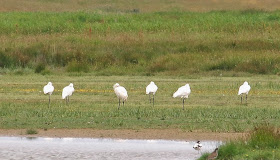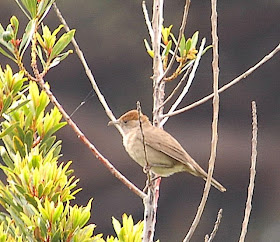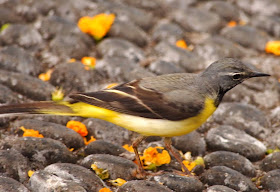An early start for a day in North Norfolk, picking up Gary in Bishop's Stortford at 4.30a.m. After a coffee break near Ely, we arrived at Titchwell at 6.30, ready to check the reserve moth trap. Nothing startling was noted here, with a large number of clouded borders present.
Off on to the reserve with red crested pochards observed, mainly in a huge state of disrepair through post breeding moult. A summer plumaged spotted redshank is always a good bird to see, with first one and then seven being seen. A flyover spoonbill, heading to Thornham was also put into the book and later, good numbers of this impressive bird were seen, both at Titchwell and later, at Cley. A singing sedge warbler showed well along the path to the beach as did the regular birds such as teal, black headed gulls, little egrets, linnets, reed buntings and avocets.
.JPG) |
| avocet |
 |
| kestrel hovering over beach path |
.JPG) |
| sedge warbler in fine voice |
 |
| spotted redshank |
 |
| lapwing on Freshmarsh |
Upon arrival at the beach, high tide was evident, so no waders. However, on the horizon were literally 1000's of scoter species. Too far off, even with a scope to make out any plumage details to check for velvet scoter etc. Also present were a handful of gannets east, all full adults, several fulmars and Gary had a solitary manx shearwater that I didn't get on to. We then headed to the Parrinder hide for more spoonbill, spotted redshank, godwits etc. Amusingly, a family party of greylags had strayed too close to an avocet family and the intrepid avocets made short work of beating up the goslings and terrifying the adult geese.
.JPG) |
| Greylag gosling ducks and heads for cover |
.JPG) |
| An adult greylag speedily moves on....... |
.JPG) |
| ........but not fast enough for the avocet! |
A few more buntings and warblers were observed before great, if distant views of two barn owls over the fields to the west of the Vistors' Centre. One bird headed off towards Patsy's whilst the other, possible juvenile, took to roosting upon a post. A little too far away for any pleasing photos, but included here nevertheless.
 |
| avocets and 2 drake red crested pochard |
.JPG) |
| hunting barn owl |
 |
| little grebe |
 |
| moulting drake teal |
We then headed off to Choseley to check for turtle doves, but all we got were grey partridge, whitethroats, yellowhammers, stock doves and pheasant, Another coffee break at Burnham Deepdale. Here, at the optic shop I wanted a small moth identifying hand lens, but the shop wasn't opening until 10a.m., so we moved on to Stiffkey Fen. Few birds, including black tailed godwits were present but not too much else. It was the end of June so we decided to head straight to Cley rather than check other sites we would normally visit. The number of birds present was an indication that this, as expected, was not going to be a record breaking day. At Cley I bought a pair of Nikon binoculars in the sale to replace my very hazy Vikings bought many years ago. A great pair of Nikons, extremely sharp and bright so I was eager to give them a test run. Off to the hides at Cley where we added house martin, plenty more spoonbills etc and I, through the scope, got on to 2 bearded tits, very distant and gone before Gary could find them following my pretty dire directions.
This was from Daukes. The other 2 hides gave up shelduck, lesser black backed gull, grey heron, marsh harrier and 4 extremely tatty ruff as well as a pair of little ringed plover.
 |
| posing avocet |
 |
| little ringed plover |
 |
| some of the Cley spoonbills |
.JPG) |
| 3 ruff in moult with an lrp behind. |
.JPG) |
| redshank |
We then thought a change of scenery would be good, so we set off for Horsey Mere. Swallowtail butterfly was on the agenda, an insect not seen in the UK by either of us. After a wander around the trail, where we scored with blackcap, marsh tit, grey wagtail, whitethroat, garden warbler, chiffchaff, marsh harrier and willow warbler, the rain ceased and for a few minutes the sun shone. Pleasingly, 2 swallowtails took to the wing and gave great flyby views. Sadly, each time they alighted it was either distant or out of sight. A couple of record shots here.
As we enjoyed another coffee at Horsey tea shop a note came on the phone about a possible female red backed shrike at nearby Winterton dunes. So we paid our £1 for the car park and looked over the enormity that is this patch. Many little terns nesting along the beach but having scanned each likely piece of vegetation for the shrike, one look at the rapidly darkening skies had us heading back to the car for the journey home.
A great day of 78 species, a UK lifer butterfly, a new pair of binoculars and a couple of year listers for me meant a thoroughly successful day was had.
Thanks to Paul at Titchwell for leaving the moth trap for me to have a rummage through.
.JPG)

.JPG)


.JPG)
.JPG)
.JPG)

.JPG)





.JPG)
.JPG)
.JPG)
.JPG)
.JPG)
.JPG)
.JPG)
.JPG)
.JPG)

.JPG)
.JPG)
.JPG)
.JPG)
.JPG)
.JPG)
.JPG)
.JPG)

.JPG)





















